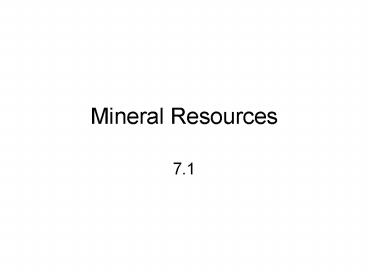Mineral Resources - PowerPoint PPT Presentation
1 / 13
Title:
Mineral Resources
Description:
Mineral Resources 7.1 Mineral Resources Mineral resources can be either metals, such as gold, U, silver, Ag, and aluminum, Al, or nonmetals, such as sulfur, S, and ... – PowerPoint PPT presentation
Number of Views:213
Avg rating:3.0/5.0
Title: Mineral Resources
1
Mineral Resources
- 7.1
2
Mineral Resources
- Mineral resources can be either metals, such as
gold, U, silver, Ag, and aluminum, Al, or
nonmetals, such as sulfur, S, and quartz, SiO2. - Metals can be identified by their shiny surfaces,
as good conductors of heat and electricity, and
they tend to bend easily when in thin sheets. - Most nonmetals have a dull surface and are poor
conductors of heat and electricity.
3
Ores
- a natural material whose concentration of
economically valuable minerals is high enough for
the material to be mined profitably - Metallic minerals such as gold, silver, and
copper, Cu, are called native elements and can
exist in Earths crust as nuggets of pure metals. - Most other minerals in Earths crust are
compounds of two or more elements.
4
(No Transcript)
5
Ores formed by cooling magma
- Some ores, such as chromium, Cr and nickel, Ni,
form as the magma cools and the dense metallic
minerals sink. - As the minerals sink, layers of these minerals
accumulate at the bottom of the magma chamber to
form ore deposits.
6
Ores formed by contact metamorphism
- lode - a mineral deposit within a rock formation.
- Heat and chemical reactions with hot fluids from
the magma can change the composition of the
surrounding rock. This process is called.
7
Ores formed by contact metamorphism
- Some ores, such as copper, Cu and zinc, Zn, form
by contact metamorphism. - Contact metamorphism also occurs when hot fluids
called hydrothermal solutions move through small
cracks in a large mass of rock. - When the minerals from the surrounding rock
dissolve into the hydrothermal solution, new
minerals will precipitate from the solution and
form narrow zones of rocks called veins
8
Ores formed by moving water
- placer deposit - a deposit that contains a
valuable mineral that has been concentrated by
mechanical action - The movement of water helps to form ore deposits.
- Tiny fragments of native elements, such as gold,
Au, are released from rock as it breaks down by
weathering. - Streams carry the fragments until the currents
become too weak to carry these dense metals,
which collect in placer deposits.
9
(No Transcript)
10
Uses of mineral material
- gemstones - a mineral, rock, or organic material
that can be used as jewelry or an ornament when
it is cut and polished - Metallic ores are sources of valuable minerals
and elements, like gold, Au, platinum, Pt, and
silver, Ag. - Some nonmetallic minerals display extraordinary
brilliance and color when they are specially cut
for jewelry. - Other nonmetallic minerals, such as calcite and
gypsum, are used as building materials.
11
Mineral Exploration and Mining
- During mineral exploration, people search for
mineral deposits by studying local geology. - Exploration teams also collect and test rock
samples to determine whether the rock contains
enough metals to make a mine profitable. - Airplanes that carry special equipment are used
to measure and identify patterns in magnetism,
gravity, radioactivity, and rock color.
12
Mineral Exploration and Mining
- Subsurface Mining- mines for minerals located
below Earths surface - Surface Mining - strips overlying rock material
to reveal mineral deposits that are located close
to Earths surface. - Placer Mining - scoop up and separate the
sediment from placer deposits to search for
minerals. - Undersea Mining -Nodules are lumps of minerals on
the deep ocean floor. However, because of their
location, these deposits are difficult to mine.
13
(No Transcript)

